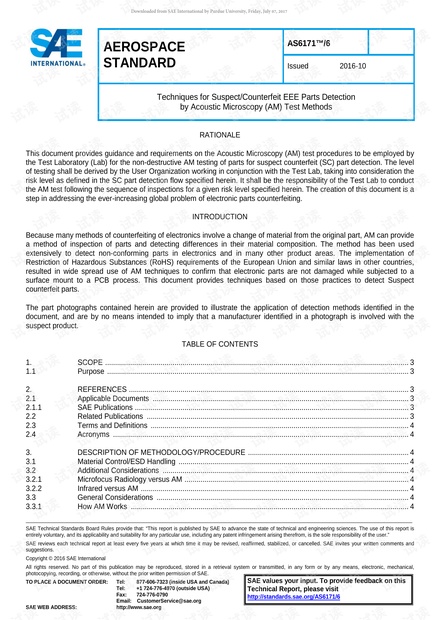
__________________________________________________________________________________________________________________________________________
SAE Technical Standards Board Rules provide that: “This report is published by SAE to advance the state of technical and engineering sciences. The use of this report is
entirely voluntary, and its applicability and suitability for any particular use, including any patent infringement arising therefrom, is the sole responsibility of the user.”
SAE reviews each technical report at least every five years at which time it may be revised, reaffirmed, stabilized, or cancelled. SAE invites your written comments and
suggestions.
Copyright © 2016 SAE International
All rights reserved. No part of this publication may be reproduced, stored in a retrieval system or transmitted, in any form or by any means, electronic, mechanical,
photocopying, recording, or otherwise, without the prior written permission of SAE.
TO PLACE A DOCUMENT ORDER: Tel: 877-606-7323 (inside USA and Canada)
Tel: +1 724-776-4970 (outside USA)
Fax: 724-776-0790
Email: CustomerService@sae.org
SAE WEB ADDRESS: http://www.sae.org
SAE values your input. To provide feedback on this
Technical Report, please visit
http://standards.sae.org/AS6171/6
STANDARD
Techniques for Suspect/Counterfeit EEE Parts Detection
by Acoustic Microscopy (AM) Test Methods
RATIONALE
This document provides guidance and requirements on the Acoustic Microscopy (AM) test procedures to be employed by
the Test Laboratory (Lab) for the non-destructive AM testing of parts for suspect counterfeit (SC) part detection. The level
of testing shall be derived by the User Organization working in conjunction with the Test Lab, taking into consideration the
risk level as defined in the SC part detection flow specified herein. It shall be the responsibility of the Test Lab to conduct
the AM test following the sequence of inspections for a given risk level specified herein. The creation of this document is a
step in addressing the ever-increasing global problem of electronic parts counterfeiting.
INTRODUCTION
Because many methods of counterfeiting of electronics involve a change of material from the original part, AM can provide
a method of inspection of parts and detecting differences in their material composition. The method has been used
extensively to detect non-conforming parts in electronics and in many other product areas. The implementation of
Restriction of Hazardous Substances (RoHS) requirements of the European Union and similar laws in other countries,
resulted in wide spread use of AM techniques to confirm that electronic parts are not damaged while subjected to a
surface mount to a PCB process. This document provides techniques based on those practices to detect Suspect
counterfeit parts.
The part photographs contained herein are provided to illustrate the application of detection methods identified in the
document, and are by no means intended to imply that a manufacturer identified in a photograph is involved with the
suspect product.
TABLE OF CONTENTS
1. SCOPE ......................................................................................................................................................... 3
1.1 Purpose ........................................................................................................................................................ 3
2. REFERENCES ............................................................................................................................................. 3
2.1 Applicable Documents ................................................................................................................................. 3
2.1.1 SAE Publications .......................................................................................................................................... 3
2.2 Related Publications .................................................................................................................................... 3
2.3 Terms and Definitions .................................................................................................................................. 4
2.4 Acronyms ..................................................................................................................................................... 4
3. DESCRIPTION OF METHODOLOGY/PROCEDURE ................................................................................. 4
3.1 Material Control/ESD Handling .................................................................................................................... 4
3.2 Additional Considerations ............................................................................................................................ 4
3.2.1 Microfocus Radiology versus AM ................................................................................................................. 4
3.2.2 Infrared versus AM ....................................................................................................................................... 4
3.3 General Considerations ............................................................................................................................... 4
3.3.1 How AM Works ............................................................................................................................................ 4
Downloaded from SAE International by Purdue University, Friday, July 07, 2017






 weixin_572722952024-11-07总算找到了自己想要的资源,对自己的启发很大,感谢分享~
weixin_572722952024-11-07总算找到了自己想要的资源,对自己的启发很大,感谢分享~ 我的内容管理
展开
我的内容管理
展开
 我的资源
快来上传第一个资源
我的资源
快来上传第一个资源
 我的收益 登录查看自己的收益
我的收益 登录查看自己的收益 我的积分
登录查看自己的积分
我的积分
登录查看自己的积分
 我的C币
登录后查看C币余额
我的C币
登录后查看C币余额
 我的收藏
我的收藏  我的下载
我的下载  下载帮助
下载帮助 
 前往需求广场,查看用户热搜
前往需求广场,查看用户热搜

 信息提交成功
信息提交成功
